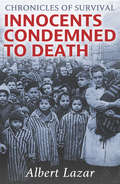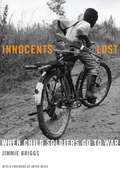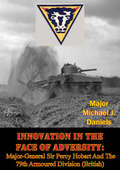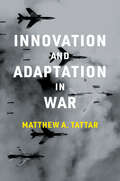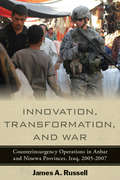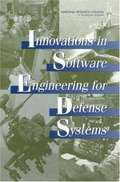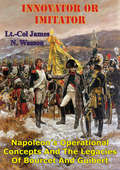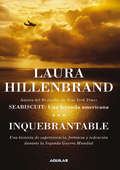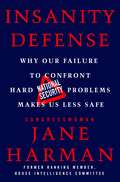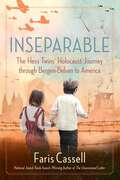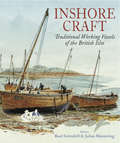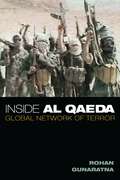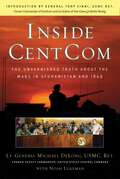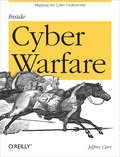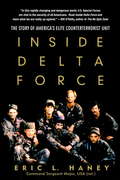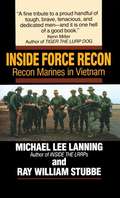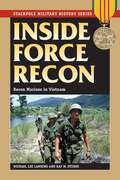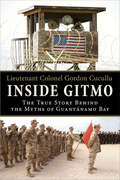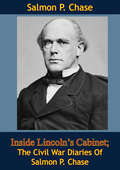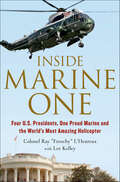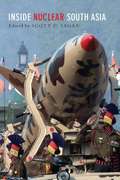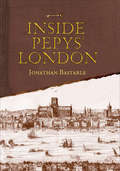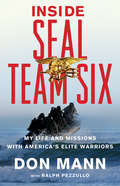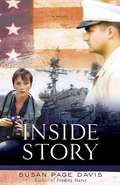- Table View
- List View
Innocents Condemned to Death: Chronicles of Survival
by Albert LazarInnocents Condemned to Death: Chronicles of Survival, first published in 1961, is a brief but moving account of the Jewish Holocaust in Hungary during World War Two. The book portrays life under the Nazi occupation and provides glimpses into a family's experiences—their separations, deportations to labor camps, interrogations, reuniting, emigration to South America—all interwoven with a powerful faith and will to survive. Included are 4 pages of photographs.
Innocents Lost: When Child Soldiers Go To War
by Jimmie BriggsIda, a member of Sri Lanka's Female Tamil Tigers, fought with one of the longest-surviving and successful guerilla movements in the world. She is sixteen. Francois, a fourteen-year-old Rwandan child of mixed ethnicity, was forced by Hutu militiamen to hack to death his sister's Tutsi children.More than 250,000 children have fought in three dozen conflicts around the world, but growing exploitation of children in war is staggering and little known. From the "little bees" of Colombia to the "baby brigades" of Sri Lanka, the subject of child soldiers is changing the face of terrorism. For the last seven years, Jimmie Briggs has been talking to, writing about, and researching the plight of these young combatants. The horrific stories of these children, dramatically told in their own voices, reveal the devastating consequences of this global tragedy.Cogent, passionate, impeccably researched, and compellingly told, Innocents Lost is the fullest, most personal and powerful examination yet of the lives of child soldiers.
Innovation In The Face Of Adversity: Major-General Sir Percy Hobart And The 79th Armoured Division (British)
by Major Michael J. DanielsOn 11 March 1943, the Chief of the British Imperial General Staff, Field Marshal Sir Alan Brooke, made a momentous decision in committing an entire British armored division, the 79th, to the task of developing equipment, tactics, and capabilities to penetrate the "Atlantic Wall," in anticipation of an Allied amphibious invasion of northwest Europe. British leaders chose Major-General Sir Percy Hobart to command this division, largely because of Hobart's affinity for leading and training armored formations, but also due to Hobart's reputation as an individualist, known to seek out unique solutions to unforeseen challenges.This thesis examines the wartime history of this unit--concentrating on aspects of equipment, tactics, organization and leadership that enabled it to ultimately succeed beyond anyone's expectations. More important, this organization provides valuable lessons for current transformation efforts. The key lessons that this subject provide include: the need for leadership that combines vision with action; a close cooperation between the military-industrial complex and the end user; and allowing space in the force structure for a unit that can perform not only standard combat missions, but can also serve as experimentation test-bed and conduit for new ideas, whether in the form of capabilities, organizational structure, or doctrine.
Innovation and Adaptation in War (Belfer Center Studies in International Security)
by Matthew A. TattarAn analysis of advances in military technology that illustrates the importance of organizational flexibility in both an attacker&’s innovations and an opponent&’s adaptations.How important is military innovation in determining outcomes during armed conflict? In Innovation and Adaptation in War, Matthew Tattar questions the conventional wisdom that, to succeed, military organizations must innovate early and often. Because successful methods of warfare are soon widely imitated or countered on the international stage, the advantages of a particular innovation quickly evaporate. Therefore, Tattar argues, large-scale innovations at the cost of organizational flexibility and the ability to adapt to an adversary&’s innovations may not be the optimal path—not just because force readiness is vital but also because innovation does not provide as long-lasting and decisive an advantage as may have been previously thought.Although other scholars have analyzed the sources of military innovation, Tattar is the first to focus on the relationship between innovation and specific military outcomes. Looking at several different types of military organizations and many different types of battles, he draws on theoretical works, in-depth historical research, and case studies, and finds that the initial advantages that are generated by innovation disappear far too rapidly in wartime for militaries to depend on them for victory. Furthermore, as Tattar demonstrates, emphasizing innovation in defense planning at the expense of organizational flexibility can have significant negative consequences. The decisive factor in successful adaptation, more often than not, is a well-positioned and flexible organization. Providing both a new framework for studying military innovation and a comprehensive review of the current literature in this field, Innovation and Adaptation in War offers crucial policymaking insights into when and under what circumstances militaries should innovate and adapt.
Innovation, Transformation, and War: Counterinsurgency Operations in Anbar and Ninewa, Iraq, 2005-2007
by James A. RussellRussell (national security affairs, Naval Postgraduate School) explores the counterinsurgency operations of Army and Marine Corps units fighting in Anbar and Ninewa provinces in Iraq from 2005 to 2007. The author uses empirical case studies, including interviews with military and civilian participants, to illustrate how these fighting units were able to quickly evolve from groups structured and trained for conventional military operations into units prepared for a wide range of combat operations. Stanford Security Studies is an imprint of Stanford U. Press. Annotation ©2011 Book News, Inc. , Portland, OR (booknews. com)
Innovations in Software Engineering for Defense Systems
by Oversight Committee for the Workshop on Statistical Methods in Software Engineering for Defense SystemsInformation on the Innovations in Software Engineering for Defense Systems
Innovator Or Imitator: Napoleon's Operational Concepts And The Legacies Of Bourcet And Guibert
by Lt.-Col James N. WassonIn 1805, a new style of operational warfare burst upon the fields of Europe as Napoleon Bonaparte's Grand Army swept from the Rhine to the Danube surrounding the Austrian army at Ulm and initiating a revolution in military affairs (RMA) whose effects are still felt today. The question remains whether this new style of warfare was merely a natural outgrowth of the work of 18th century military thinkers, whose theories were imitated by a dynamic leader, or did Napoleon bring something new to warfare, a true innovation in the conduct of operational warfare? This is the central question that this monograph will attempt to answer.David Chandler maintains that "Napoleon contributed little new." As we struggle today with the implications of a possible RMA, it is important that we fully understand the forces that caused former RMA's to occur. For the historian, it is also important that we get our interpretations of past events as correct as possible. Was this a RMA that would have happened with any energetic leader who strictly followed the teachings of Bourcet and Guibert, as a sort of TTP put together by theorists, or did Napoleon take their theories, and meld them with his own ideas to create a new form of warfare and initiate a RMA? Does a true RMA require more than just theories and doctrine, does it require an inquiring mind on the part of the practitioner as well? These questions give relevance to the research question of this monograph.The monograph concludes that Napoleon did not imitate the two thinkers, and that the RMA initiated by him was more than just an implementation of techniques proposed by theorists. The RMA in 1805 required an imaginative practitioner who could grasp the salient features of theory and put them to use in new ways. To initiate the RMA innovation by the war fighter was required, not mere imitation.
Inquebrantable
by Laura HillenbrandRetrato de la extraordinaria historia de Louie Zamperini, un atleta olímpico que se convirtió en aviador de la Segunda Guerra Mundial, en náufrago y en prisionero japonés. Inquebrantable fue adaptada en 2014 por Angelina Jolie, película que tuvo 3 nominaciones a los premios Oscar y fue incluida por el American Film Institute en el Top 10 de las mejores películas del año. Una historia de supervivencia, valor y resistencia durante la Segunda Guerra Mundial. Louie Zamperini, niño problemático, atleta olímpico, aviador durante la Segunda Guerra Mundial, náufrago en el Pacífico Sur, prisionero de los japoneses... un superviviente. Junio, 1943. Louie Zamperini, bombardero de la Segunda Guerra Mundial y atleta olímpico, se encuentra tendido sobre una pequeña balsa a la deriva en la inmensidad del océano Pacífico. Junto a él yacen otros dos compañeros. Sus cuerpos están abrasados por el sol y un grupo de tiburones los acecha cada minuto. Llevan 27 días sin rumbo y hace mucho que perdieron la esperanza de ser rescatados. Un sonido metálico los alerta... es un avión -pueden ver su destello a lo lejos-, Zamperini arroja dos bengalas. Los náufragos se desesperan, pero de pronto lo ven reaparecer. La tripulación los ha visto. El avión empieza a descender y los hombres se percatan con espanto de que se trata de un bombardero japonés y de que ellos son su objetivo. No hay salida. Así comienza Inquebrantable, una de las historias reales más impactantes de la Segunda Guerra Mundial. Laura Hillenbrand, autora de Seabiscuit, articula con la destreza de las grandes novelistas la vida de un hombre extraordinario que tuvo una infancia complicada, que descubrió que poseía un increíble don para correr que lo llevó a participar en los Juegos Olímpicos de Berlín y que se convirtió en aviador durante la guerra, una experiencia dramática que lo puso al límite envarias ocasiones. Una obra imprescindible cuya lectura atrapa desde las primeras páginas, una historia de supervivencia, valor y resistencia que no dejará indiferente a nadie. Una odisea contemporánea.
Insanity Defense: Why Our Failure to Confront Hard National Security Problems Makes Us Less Safe
by Jane HarmanAn insider's account of America's ineffectual approach to some of the hardest defense and intelligence issues in the three decades since the Cold War ended.Insanity can be defined as doing the same thing over and over again but expecting a different result. As a nation, America has cycled through the same defense and intelligence issues since the end of the Cold War. In Insanity Defense, Congresswoman Jane Harman chronicles how four administrations have failed to confront some of the toughest national security policy issues and suggests achievable fixes that can move us toward a safer future.The reasons for these inadequacies are varied and complex, in some cases going back generations. American leaders didn’t realize soon enough that the institutions and habits formed during the Cold War were no longer effective in an increasingly multi-power world transformed by digital technology and riven by ethno-sectarian conflict. Nations freed from the fear of the Soviets no longer deferred to America as before. Yet the United States settled into a comfortable, at times arrogant, position as the lone superpower. At the same time our governing institutions, which had stayed resilient, however imperfectly, through multiple crises, began their own unraveling.Congresswoman Harman was there—as witness, legislator, exhorter, enabler, dissident and, eventually, outside advisor and commentator. Insanity Defense is an insider’s account of decades of American national security—of its failures and omissions—and a roadmap to making significant progress on solving these perennially difficult issues.
Inseparable: The Hess Twins' Holocaust Journey through Bergen-Belsen to America
by Faris CassellSee the Holocaust through the Eyes of Children.Stefan and Marion Hess's happy childhood was shattered in 1943. Torn from their home in Amsterdam, the six-year-old twins and their parents were deported to a place their mother called "this dying hell"—the infamous concentration camp at Bergen-Belsen. Inseparable is the vivid account of one family's struggle to survive the Holocaust. In the camp, the children ran from SS soldiers, making it a game to see who could get closest to the guard towers before being warned they would be shot. Stefan and Marion witnessed their father beaten beyond recognition, dodged strafing warplanes, and somehow survived in a place where "the children were looking for bread between the corpses." Above all, this is the unforgettable story of a young mother and father who were willing to sacrifice everything for their children. From the Hesses' prosperous pre-war life in Germany to their desperate ride in a bulletstrafed boxcar through the rubble of the collapsing Third Reich, Faris Cassell weaves Stefan and Marion&’s personal memories and historical details into a gripping narration of their family&’s heroic fight for their lives. As the number of Holocaust survivors dwindles, the Hess twins' account of their childhood ordeal forces the reader to grapple with pure evil. And more important, it is an opportunity to offer the most meaningful of tributes to victims and survivors of the Third Reich—remembrance.
Inshore Craft: Traditional Working Vessels of the British Isles
by Basil Greenhill Julian ManneringThis comprehensive reference work describes and illustrates some 200 types of inshore craft that once fished and traded, under oar and sail, around the coasts of the British Isles. The types are arranged by coastal area and each is described in terms of its shape and design, fitness for location and purpose, build, evolution and geographical distribution. Details of dimensions, rig, building materials, seamanship and the survival of examples are given where known, while hundreds of line drawings and photographs show the vessels in their original forms.A team of twelve experts describe all these boat types and, in addition, there are introductions to the main geographic areas outlining the physical environments, fisheries and other uses of the sea that have influenced boat design; maps of all the areas show ports and physical features.At the beginning of the last century sail and oar dominated fisheries and local trade: one hundred years later those craft have all but vanished. This book brings alive for maritime historians and enthusiasts, traditional boat sailors, modelmakers, and all those with an interest in local history, the vast array of craft that were once such a significant feature of our inshore seas.Inshore Craft is a spectacular achievement—Wooden Boat Magazine
Inside CentCom: The Unvarnished Truth About The Wars In Afghanistan And Iraq
by Tony Zinni Noah Lukeman Michael DelongInside CentCom: The Unvarnished Truth About The Wars In Afghanistan And Iraq by Michael DeLong, Noah Lukeman, and an introduction by Tony Zinni
Inside Cyber Warfare: Mapping the Cyber Underworld (Oreilly And Associate Ser.)
by Jeffrey CarrWhat people are saying about Inside Cyber Warfare"The necessary handbook for the 21st century."--Lewis Shepherd, Chief Tech Officer and Senior Fellow, Microsoft Institute for Advanced Technology in Governments"A must-read for policy makers and leaders who need to understand the big-picture landscape of cyber war."--Jim Stogdill, CTO, Mission Services AccentureYou may have heard about "cyber warfare" in the news, but do you really know what it is? This book provides fascinating and disturbing details on how nations, groups, and individuals throughout the world are using the Internet as an attack platform to gain military, political, and economic advantages over their adversaries. You'll learn how sophisticated hackers working on behalf of states or organized crime patiently play a high-stakes game that could target anyone, regardless of affiliation or nationality.Inside Cyber Warfare goes beyond the headlines of attention-grabbing DDoS attacks and takes a deep look inside multiple cyber-conflicts that occurred from 2002 through summer 2009.Learn how cyber attacks are waged in open conflicts, including recent hostilities between Russia and Georgia, and Israel and PalestineDiscover why Twitter, Facebook, LiveJournal, Vkontakte, and other sites on the social web are mined by the intelligence services of many nationsRead about China's commitment to penetrate the networks of its technologically superior adversaries as a matter of national survivalFind out why many attacks originate from servers in the United States, and who's responsibleLearn how hackers are "weaponizing" malware to attack vulnerabilities at the application level
Inside Delta Force: The Story of America's Elite Counterterrorist Unit
by Eric HaneyNow the inspiration for the CBS Television drama, "The Unit." Delta Force. They are the U.S. Army's most elite top-secret strike force. They dominate the modern battlefield, but you won't hear about their heroics on CNN. No headlines can reveal their top-secret missions, and no book has ever taken readers inside--until now. Here, a founding member of Delta Force takes us behind the veil of secrecy and into the action to reveal the never-before-told story of 1st Special Forces Operational Detachment-D (Delta Force).
Inside Force Recon: Recon Marines in Vietnam
by Michael Lee Lanning Ray William StubbeOperating in 4 to 8 man teams, the patrols of Force Recon ventured far into the very backyard of the enemy, the North Vietnamese Army.
Inside Force Recon: Recon Marines in Vietnam (Stackpole Military History Series)
by Michael Lee Lanning Ray W. StubbeBehind-enemy-lines stories of elite Marines in VietnamForce Recon companies were the eyes and ears of the Marine Corps in Vietnam. Classified as special operations capable, Force Recon Marines ventured into the enemy&’s backyard to conduct reconnaissance and launched deliberate strikes against the enemy. Lanning and Stubbe blend analysis and you-are-there stories of Force Recon in action to create the definitive account of Recon Marines.
Inside Gitmo: The True Story Behind the Myths of Guantanamo Bay
by Gordon CuculluThe U.S. military detention center at Guantánamo Bay—known to the public as Gitmo—has been called the American Gulag, a scene of medieval horrors where innocent farmers and goat herders swept up in Afghanistan and Iraq have been sequestered, tortured, and abused for years on end without access to legal counsel or basic medical services.Gordon Cucullu, a retired army colonel, was so appalled by these reports that he decided to see for himself. In a series of visits he inspected every corner of the camp and interviewed dozens of personnel, from guards and interrogators to cooks and nurses. The result—coming just as the Obama administration wants to close the facility—is a riveting description of daily life for both prisoners and guards. Cucullu describes the six camps reserved for different levels of compliance, details the treatment of prisoners, and examines their experiences in detail, including the techniques used to interrogate them, the food they eat, their medical care, how they communicate with one another, and the many ingenious ways they contrive to assault and injure their guards. While some prisoners were indeed treated harshly in the early days, when the hastily built camp was flooded with battlefield captures and fears ran high of another 9/11-style attack, Cucullu finds that these excesses were quickly corrected. Current treatment and oversight routines exceed the standards of any maximum-security prison in the world. Despite what the public has heard, these are not innocent goatherds but dedicated jihadists whose overriding goal—as they themselves candidly say—is to kill Americans. Should they now be released to return to the fight, perhaps on American soil? Read this book and decide for yourself.
Inside Hitler's Germany: Life Under The Third Reich
by Adrian GilbertThere have been many histories of World War II and many analyses of the Third Reich, but few show what it was actually like to live under the Nazi regime. Inside Hitler's Germany attempts just that. Beginning with an examination of the early thirties, before the full horrors at the heart of the regime were evident, this extensively illustrated book looks at all aspects of life under Hitler's government.
Inside Lincoln’s Cabinet; The Civil War Diaries Of Salmon P. Chase: The Civil War Diaries Of Salmon P. Chase
by David Herbert Donald Salmon P. ChaseThe vivid, lucid and extremely illuminating diary of Salmon P. Chase remained scattered until 1954 when they were published under the editorship of eminent Civil War historian David H. Donald. Chase served as Secretary of the Treasury in President Lincoln's cabinet from 1861 to 1864, during the Civil War, despite the crisis he instituted the establishment of a national banking system and the issue of paper currency. Ambitious, talented and underhand, his diaries reveal the Civil War at its highest level on the Union side."SOME of the best American diaries record the turbulent years of the Civil War... Of the important Northern Civil War diaries, one has been unduly neglected--the journals of Salmon Portland Chase, Lincoln's Secretary of the Treasury....For a good many years I have hoped to edit Chase's Civil War diaries, believing that the importance both of the man and of his position warranted publication, I have tried to present the diaries just as Chase wrote them. Beyond standardizing the dates which head each entry, I have not tampered with the text."-David H. Donald.
Inside Marine One: Four U.S. Presidents, One Proud Marine, and the World’s Most Amazing Helicopter
by Col. Ray L'Heureux Lee KelleyCol. Ray "Frenchy" L'Heureux always dreamed of bring a pilot. Growing up, he built airplane models and dreamed about soaring over the earth. When he was twelve, his mom treated him to a flying lesson at the local airfield. Taken on a short flight by an instructor and allowed to operate the controls for part of the flight, he was hooked forever. It wasn't until he was running low on college funds and saw a recruiter at his college that he joined the Marines and began the journey towards his dream from Parris Island to Bravo Company and, then, officer training school. One day at an airfield when President Reagan landed on this way to a fundraiser, Frenchy's life changed forever when encountered HMX1, the squadron that flies the President in Marine One. When he saw the white-topped Sea King and White Hawk helicopters, he was determined to become part of that elite group. Inside Marine One is Col. L'Heureux's inspiring story of a young man who dreamed of flying, trained, studied and worked hard to become the pilot who ended up serving four US Presidents - George H.W. Bush, Bill Clinton, George W. Bush and Barack Obama. It's also a personal guided tour inside the world's most famous helicopter by a man who knows that flying machine better than any other. Inside Marine One is a great American success story of a young boy who dreamed big, worked hard and finally flew the President of the United States as his number one passenger.
Inside Nuclear South Asia
by Scott D. SaganFor policy makers, legislators, analysts, intelligence and military professionals, students, and researchers, Sagan (political science, Stanford U. ) compiles six essays that consider the spread of nuclear weapons in India and Pakistan and the potential consequences of proliferation, including the possibility of war. Scholars of government, Asian studies, international relations and politics, national security affairs, and political science in the US and UK illustrate the complexity of the decision-making process and the diversity of opinions on nuclear weapons issues in these countries by providing insight on the domestic politics and organizational interests behind policies and a critique of narrow views of nuclear proliferation in general. They examine why nuclear capabilities have not led to peace and consider domestic political interests, civil-military relations, and bureaucratic processes that contribute to policy choices related to nuclear testing at various times. Annotation ©2009 Book News, Inc. , Portland, OR (booknews. com)
Inside Pepys' London
by Jonathan BastableInside Pepys' London reveals a vivid picture of London at a critical point in history - poised to become a major centre of international commerce and culture. It provides accounts of all aspects of contemporary life, from the arts and entertainment, to politics and religion. Though no king or great general, thanks to his diary Samuel Pepys is one of the most interesting characters in history. His life encompassed happenings of huge historical and human impact - the execution of Charles I and the Great Fire of London to name but two. This book takes Pepys' diary, which he kept almost daily from 1660-1669, as its central resource, but also includes a range of other contemporary sources to provide a fascinating and vivid picture of the times.
Inside SEAL Team Six: My Life and Missions with America's Elite Warriors
by Don MannThe Inside Story of America's Ultimate Warriors. When Osama bin Laden was assassinated, the entire world was fascinated by the men who had completed the seemingly impossible mission that had dogged the U.S. government for over a decade. SEAL Team 6 became synonymous with heroism, duty, and justice. Only a handful of the elite men who make up the SEALs, the US Navy's best and bravest, survive the legendary and grueling selection process that leads to becoming a member of Team 6, a group so classified it technically does not even exist. There are no better warriors on Earth. Don Mann knows what it takes to be a brother in this ultra-selective fraternity. As a member of Seal Team Six for over eight years and a SEAL for over seventeen years, he worked in countless covert operations, operating from land, sea, and air, and facing shootings, decapitations, and stabbings. He was captured by the enemy and lived to tell the tale, and he participated in highly classified missions all over the globe, including Somalia, Panama, El Salvador, Colombia, Afghanistan, and Iraq. As a coordinator for several civilian SEAL training programs, and as a former Training Officer of SEAL Team Six, he was directly responsible for shaping the bodies and minds of SEALs who carried out the assassination of Osama bin Laden. But to become a SEAL, Mann had to overcome his own troubled childhood and push his body to its breaking point--and beyond. INSIDE SEAL TEAM 6 is a high octane narrative of physical and mental toughness, giving unprecedented insight to the inner workings of the training and secret missions of the world's most respected and feared combat unit.
Inside Story (Frasier Island series, Book #3)
by Susan Page DavisFollowing up on the adventures of men in uniform in Frasier Island and Finding Marie, Susan Page Davis offers readers another suspenseful novel of international diplomacy and romance. Claudia Gillette, an upscale magazine correspondent, will go to any lengths for a good story. Bill White, a navy lieutenant, performs secret missions all over the world. Attraction sizzles between them, but these two can't synchronize their globe-trotting watches long enough for a date. Claudia also has more than romance in mind...she wants the inside story on Bill's exotic assignments. When she goes over his head and obtains permission to join his outfit on a sensitive mission in the Philippines, Bill is both angry and afraid for her. Will her presence endanger his team? When things go badly, only faith in God can give them hope for tomorrow...but even if they both make it, what's the inside scoop on Bill and Claudia having a future together?
